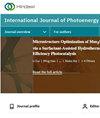快速变化大气条件下光伏系统模型参考自适应控制的动态性能改进
IF 2.1
4区 工程技术
Q3 CHEMISTRY, PHYSICAL
引用次数: 0
摘要
光伏(PV)系统的有效性可以通过使用最大功率点跟踪(MPPT)来提高。文献提出了许多跟踪最大功率点(MPP)的方法。然而,在快速变化的大气条件下,这一数量的方法通常在达到MPP时表现出高收敛速度、实现的复杂性、功率波动、超调以及达到MPP的巨大困难,从而影响光伏系统的效率。为了提高光伏系统在大气快速变化下的性能,本文提出了模型参考自适应控制(MRAC),作为一种基于参考模型(如MPP处的最佳电压和电流)跟踪MPP的技术(V MPP和I MPP)。使用MATLAB/Simulink环境生成仿真结果;Kyocera Solar KC 130 GT模块在这里用作光伏发电厂,连接到升压转换器,为电阻负载供电。利用李雅普诺夫理论证明了系统的稳定性。将使用所提出的方法获得的模拟结果与通过扰动和观测(P&O)、增量电导(INC)、变步长增量电导(VSINC),粒子群优化(PSO)和灰狼优化(GWO)等技术获得的结果进行了比较,从而显示出在标准测试和快速变化的大气条件下,所提出的技术在收敛速度和跟踪效率方面比其他技术有很大的改进。仿真结果表明,该方法具有良好的跟踪效果(>99.88%),收敛时间短(<0.01 s) ,以及在快速变化的大气条件下的简单实现复杂性,而没有瞬态和稳态功率振荡、过冲和抖振效应,从而使能量损失大大最小化,并且所提出的技术在快速变化大气条件下精确地达到了MPP。本文章由计算机程序翻译,如有差异,请以英文原文为准。
Dynamic Performance Improvement Using Model Reference Adaptive Control of Photovoltaic Systems under Fast-Changing Atmospheric Conditions
The effectiveness of a photovoltaic (PV) system can be increased by using maximum power point tracking (MPPT). The literature has suggested a number of methods for tracking the maximum power point (MPP). However, this number of methods most often presents a high convergence speed in reaching the MPP, complexity under their implementation, power fluctuations, overshoots, and great difficulty in reaching the MPP under fast-changing atmospheric conditions, thus influencing the efficiency of PV systems. Intending to improve the performance of PV systems under rapid changes in the atmosphere, this paper proposes model reference adaptive control (MRAC) as a technique for tracking the MPP based on the employ of reference models such as optimal voltage and current at the MPP (
V
MPP
and
I
MPP
). The MATLAB/Simulink environment is used to produce the simulation results; the Kyocera Solar KC 130 GT module is used here as a photovoltaic power plant, connected to a boost converter, supplying a resistive load. The Lyapunov theory was used to demonstrate the stability of the system. The simulation outcomes obtained using the suggested method are compared with those obtained by techniques such as perturb and observe (P&O), incremental conductance (INC), variable step incremental conductance (VSINC), particle swarm optimization (PSO), and grey wolf optimization (GWO), thus showing a very large improvement under standard test and fast-changing atmospheric conditions of the technique proposed on the other techniques in terms of convergence speed and tracking efficiency. The simulation results prove that the suggested method has great tracking effectiveness (>99.88%), less time for convergence (<0.01 s), and simple implementation complexity under fast-changing atmospheric conditions without both transient and steady-state power oscillations, overshoots, and chattering effects, thus causing a great minimization of energy losses, and the proposed technique reaches exactly the MPP under fast-changing atmospheric conditions.
求助全文
通过发布文献求助,成功后即可免费获取论文全文。
去求助
来源期刊
CiteScore
6.00
自引率
3.10%
发文量
128
审稿时长
3.6 months
期刊介绍:
International Journal of Photoenergy is a peer-reviewed, open access journal that publishes original research articles as well as review articles in all areas of photoenergy. The journal consolidates research activities in photochemistry and solar energy utilization into a single and unique forum for discussing and sharing knowledge.
The journal covers the following topics and applications:
- Photocatalysis
- Photostability and Toxicity of Drugs and UV-Photoprotection
- Solar Energy
- Artificial Light Harvesting Systems
- Photomedicine
- Photo Nanosystems
- Nano Tools for Solar Energy and Photochemistry
- Solar Chemistry
- Photochromism
- Organic Light-Emitting Diodes
- PV Systems
- Nano Structured Solar Cells

 求助内容:
求助内容: 应助结果提醒方式:
应助结果提醒方式:


